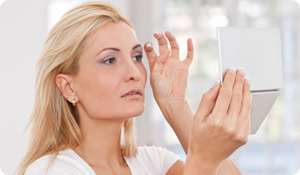
Actinic Keratosis (ak-TIN-ik ker-uh-TOE-sis), also known as AK or solar keratoses, is a precancerous skin condition that begins in the top layer of the skin. Extended exposure to the sun's ultraviolet radiation rays causes AK, so you generally see it in areas regularly exposed to the sun.
The main risk factors are age and lifetime accumulation of sun exposure. Men are slightly more likely to develop AK, and African American, Hispanic, and Asian populations are less susceptible to AK.
Other risk factors include:
- Fair complexion and freckles
- Skin that burns easily, doesn't tan, or tans poorly
- Blue, green, or light eyes
- Red or blond hair
Actinic Keratosis Common Sign and Symptoms
AK appears as scaly or crusty lesions on the skin (there's seldom just one lesion), which are often red, but can also be tan, pink, or flesh-colored. They typically range from 1 to 3 millimeters in diameter, and are recognizable more by touch rather than sight. Occasionally, the lesions itch or produce a prickly or tender sensation. They may become inflamed or surrounded by redness, and, in rare cases, bleed.
AK is benign, but poses a risk factor for skin cancer. The National Cancer Institute says about 48,000 people are treated annually for early forms of cancer that involve only the top layer of the skin, and more than two million are treated for basal cell carcinoma or squamous cell carcinoma (SCC); both of which are non-melanoma forms of skin cancer.
According to the American Academy of Dermatology, 1 out of 5 Americans will develop skin cancer and approximately 40 to 65 percent of SCCs begin as untreated AK. The Academy estimates that 60 percent of predisposed individuals older than 40 have at least one active AK.
Actinic Cheilitis, A More Aggressive Form
One more aggressive form of Actinic Keratosis is Actinic Cheilitis. Actinic Cheilitis causes cracking or peeling of the lower lip and does not respond to lip balm. About 1 out of 5 of these lesions metastasizes (spreads) after developing into SCC.
Physicians typically treat AK by physically removing the lesion or applying a topical medicine. In January 2012, the Food and Drug Administration approved another short-term, topical therapy for AK.
If you have lesions that fit the description above, have your physician look at them, especially if they become painful, itch or burn, ooze or bleed, become scaly or crusty, and change size, shape, or elevation.
Sources:
National Cancer Institute. "General Information About Skin Cancer." Web. 2 May 2011.
http://www.cancer.gov/cancertopics/pdq/treatment/skin/Patient
National Cancer Institute. "Genetics of Skin Cancer (PDQ®)." Web. 26 April 2012.
http://www.cancer.gov/cancertopics/pdq/genetics/skin/HealthProfessional
National Cancer Institute. "What You Need To Know About Melanoma and Other Skin Cancers." Web. 11 January 2011.
http://www.cancer.gov/cancertopics/wyntk/skin
Shoimer, I., BSc, Rosen, N., MD, and Muhn, C., MD. "Current Management of Actinic Keratoses." Skin Therapy Letter 15(5) (2010): 5-7. Medscape Medical News. Web. 24 June 2010.
http://www.medscape.com/viewarticle/723136
Kerr, Martha. "Short-Term Topical Treatment for Actinic Keratosis Approved." Medscape Medical News. Web. 26 January 2012.
http://www.medscape.com/viewarticle/757532
Skin Cancer Foundation. "What is Actinic Keratoses?" Web.
http://www.skincancer.org/skin-cancer-information/actinic-keratosis
American Osteopathic College of Dermatology. "Actinic Keratoses." Web.
http://www.aocd.org/skin/dermatologic_diseases/actinic_keratosis.html
Mayo Clinic. "Actinic Keratosis." Web. 7 January 2011.
http://www.mayoclinic.com/health/actinic-keratosis/DS00568/METHOD=print&DSECTION=all





